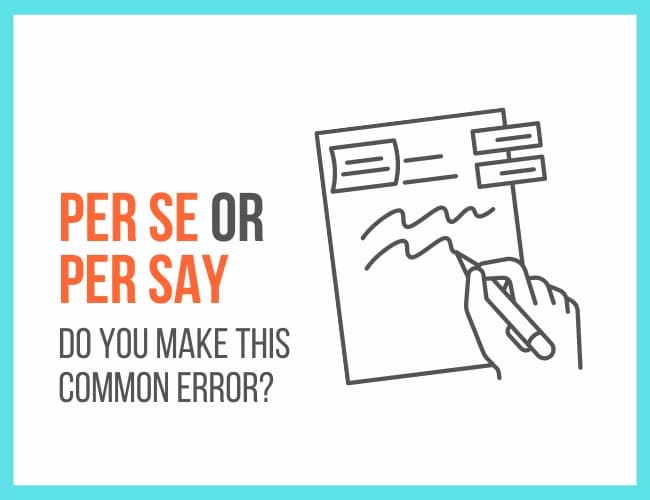The article Do You Make This Common Error? Per Se or Per Say appeared first on The Write Practice.
Sometimes people confuse the latin term per se with per say, especially because they sound identical in everyday speech. Today’s writing tip clears up any confusion.
Is it per se or per say? Definition and explanation
Per se is a Latin term or phrase meaning “in itself” or “by itself.” It is typically used to refer to something that stands alone without any additional context or explanation needed. It can also refer to a thing’s essence.
The correct spelling is always per se.
“Per se” is an incorrect usage of per se and should be avoided. It has no real meaning in the English language and it is not a Latin phrase. Instead, it is just a misspelling of per se.
Examples of usage
For example, a person might say, “This new policy is not illegal per se.” In this context, the phrase means that the policy does not necessarily break any laws—it stands alone and is not dependent on any other factors or circumstances.
One might also use the phrase “per se” to refer to a particular characteristic of something. For instance, you might say, “This painting is not particularly interesting per se, but its message resonates with viewers.”
In this case, you would be indicating that the painting itself is not necessarily fascinating or captivating on its own merits but nonetheless has a certain quality or value.
Another way to use the phrase per se is to indicate something that exists independently and separately from other things.
For example, you might say, “This organization is not a part of our company per se, but they share many of the same values.” Here, you are indicating that the organization is independent from your company but still has some common ground.
Finally, one might use the phrase “per se” to refer to something that cannot be broken down into smaller components. For instance, you might say, “This concept has no parts per se, but it is made up of various elements.”
Here, you are indicating that the concept itself is indivisible but consists of many separate components.
The accurate spelling: per se
In summary, understanding the difference between per se and per se is important to ensure proper grammar usage. Per se means “in itself” or “by itself” and should be used to refer to something that stands alone without any additional context or explanation needed. Per say is not a real phrase and should be avoided as it is simply misspelling.
Are there any words you always misspell or that irritate you when you see them misspelled? Share in the comments.
Need more grammar help? Election season, or not, my favorite tool that helps find grammar problems and even generates reports to help improve my writing is ProWritingAid. Works with Word, Scrivener, Google Docs, and web browsers. Also, be sure to use my coupon code to get 20 percent off: WritePractice20
PRACTICE
Take fifteen minutes and write about something that, under normal circumstances, doesn’t particularly irritate or excite you, but under the right circumstances can either thrill you beyond measure or make your skin crawl. This can be politics, sports, sports fans, concerts, or furry conventions (judgment-free zone here). Post your practice in the Pro Practice Workshop and take some time to read and comment on your fellow writers’ work.
The article Do You Make This Common Error? Per Se or Per Say appeared first on The Write Practice. The Write Practice – The Online Writing Workbook
Go to Source
Author: Liz Bureman

